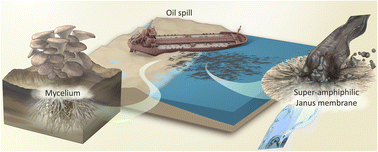Surface engineering of a superamphiphilic, self-growing fibrous Janus membrane prepared from mycelium†
Abstract
The increasing demand for effective oil–water separation materials has encouraged the exploration of sustainable and ecofriendly solutions. In this study, we investigate the surface engineering of a superamphiphilic, self-growing fibrous membrane derived from the Pleurotus ostreatus mycelium. A nanoporous membrane contactor facilitated the harvest of a fibrous Janus membrane by blocking the contact between the mycelium and the growth medium yet allowing nutrient transport to the mycelium. The analysis of the hydrophilicity of the membrane surface and at the mycelium–membrane interface revealed improved wettability and surface fine-tuning. The hydrophilic side was observed at the membrane–mycelium interface, whereas the hydrophobic side displayed a dense layer of closely packed fibrous hyphae. A gradient in the hypha density was revealed through Z-stack fluorescence confocal microscopy and two-dimensional segmentation analysis. The selectivity in oil–water separation was fine-tuned, which provided a sustainable and ecofriendly approach for addressing environmental challenges. The findings of this study emphasize the significance of harnessing natural compounds and self-growing fibrous mycelium as an innovative approach to surface engineering for advanced separation technologies. For the first time, we have successfully demonstrated a new application of membrane contactors for developing superamphiphilic mycelium materials.



 Please wait while we load your content...
Please wait while we load your content...